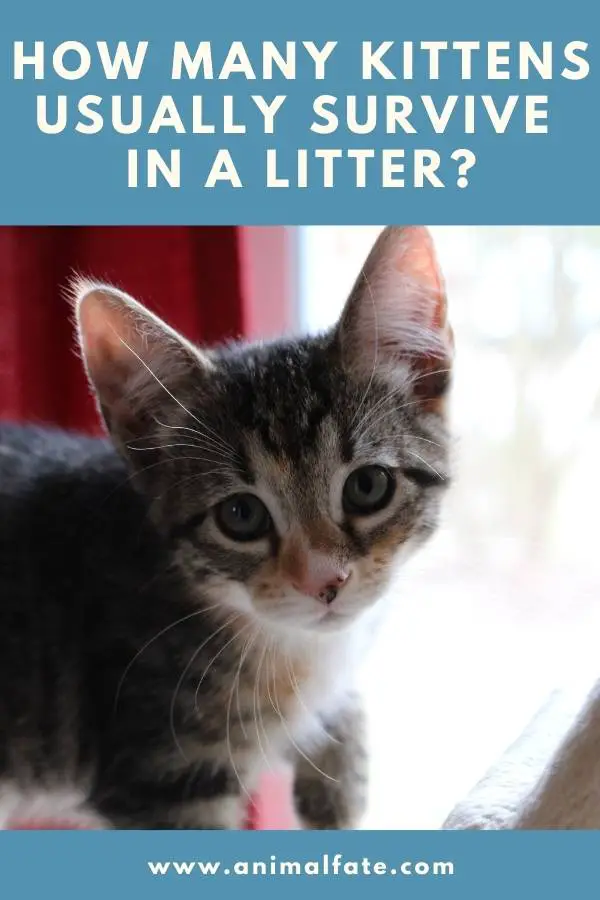Around 70-85% of kittens survive in a litter. This may vary according to the mother cat’s health, but it is reported that the kitten mortality rate is 15-35%. With an average of 3 to 5 kittens per litter, there is a good chance only one will be dead, or they will be all alive and healthy.
If you already saw a few birthing processes, you may already know that some kittens usually don’t survive.
While it may be saddening, it’s a natural thing in a cat’s reproduction, and it’s something we can’t control.
Let’s dive in deeper for a better understanding.
Contents
How many kittens survive in a litter?
The survival of kittens depends mostly on their health once they are born from their mothers.
Generally, the pre-weaning mortality of kittens is about 15-30%. That means for every ten kittens born, one to three of them may die before even learning to feed on their own.
Kittens learn to eat solid food during their fourth week. Thus, a kitten is more prone to dying in its first three weeks.
If a kitten is already weak or has defects upon birth, likely, it won’t survive within the first three weeks.
Further, about 10% of all kittens are stillborn. That means for every ten kittens born, one of them is likely stillborn.
While it may seem saddening, it’s not something we cat owners can control. It’s something natural in a cat’s reproduction process.
Related – Why do cats eat their placenta?
How many kittens are usually in first litter?
Although death in kittens is likely to happen, it seems cats compensate for it by the quantity.
Unlike us humans, a feline’s litter consists of more than one kitten. Generally, an ordinary cat may give birth to two to five kittens.
Further, they can even have more than that. The highest record of a cat litter has 19 kittens. Many cats can give birth between 8-12 kittens.
A cat’s first birthing usually consists of a smaller litter, not more than 2-5 kittens.
The next ones can be the same or can be more. Most felines have a greater chance of having a bigger litter as they grow older.
Still, despite the quantity, some kittens may not even survive. In fact, the whole litter of kittens may die.
You May Also Read – Why does my cat keep bringing me her kittens?
Why would a whole litter of kittens die?

Such a terrible incident can be quite saddening. Still, some kittens will inevitably die during the birthing process.
With an average of two to five kittens every birth, it can be quite frustrating to see one or two as stillborn. It can be worse if the whole litter dies.
Although such an instance rarely happens, it can be possible that all of the kittens wouldn’t survive.
When this event happens, it doesn’t mean all kittens are stillborn. Some kittens may be alive but are weak enough to survive. Others, during the process, may have defects and illnesses.
Remember, it’s not only the birthing process that plays a role in such a significant death rate. It also includes the following weeks.
According to a study, kittens are prone to death. Further, they can be at their most vulnerable time during the first eight weeks of their lives.
Most kittens that are weak enough pass much earlier, from the first up until the third week.
At the same time, mother cats play a role in a kitten’s survival as well. You see, cats have their unique way of taking care of their young.
While they can be overprotective, they can also be the cause of death. These instances happen when they get under a lot of stress. They respond by either eating or abandoning their young.
Further, when cats sense that their kitten has defects, they prevent it from feeding. They do this, thinking that it will not survive.
It may seem like cats don’t care about their kitten’s well-being. However, they make such a response as they focus on taking care of the healthy ones.
Thus, if you see a dead kitten, here’s what you can do.
Why your cat moves her kittens? Learn why!
What to do with a dead kitten after birth?
If you see a stillborn kitten, make sure it remains near its mother cat. Let it so until your cat becomes aware that her young are dead.
Your cat may know immediately. At the same time, your pet may be unaware and continue to groom it and clean it from the afterbirth.
If you would pay attention, there will be a moment when she’ll know. In that particular instance, your pet will turn its attention to the ones that are still alive.
There are instances when a cat eats her young. One of the reasons why they do is that the kitten is stillborn. Read about this matter further in this related article.
A stillborn kitten’s skin will cool eventually. Once it does, you can remove it from the birthing box, slowly and gently.
It will help if you talk to your cat while you’re taking her dead kitten out. Use a soft & clean cloth, as a dead kitten can be difficult to pick up with only bare hands.
If you can, place the kitten in a small box, or wrap it with a cloth before burying it. Hold its body in your hands as you lay it on the ground.
Afterward, go back inside and wash your hands. Join your cat, and focus on the fact that your pet and some of its kittens survived.
It can be quite saddening, indeed. However, it’s not a reason enough to forget that there are new kittens that surround you, alive and healthy.
Do cats feel love for their babies? Read here.
Summary
Indeed, it can be quite frustrating to know that there are kittens who don’t get to live and grow.
Most kittens are lucky enough to survive in a litter. However, there are those weak sufficient to pass after a few weeks.
Still, it’s not something we should be dwelling on. During these instances, it’s best to focus on the fact that our cats survive. Not only that, they still have remained live and healthy kittens to take care of from now on.
As owners, we need to support our cats and to respond to whatever aid they’ll need with their young.
Resources
Image credits – Photos by Haley Owens and Juan Carlos Cajahuaman on Unsplash



